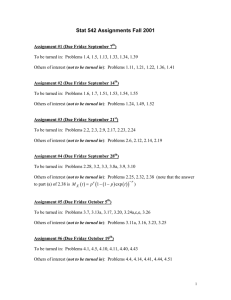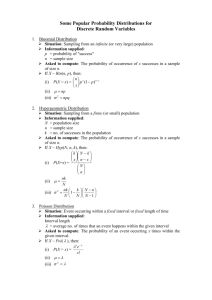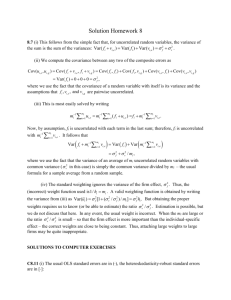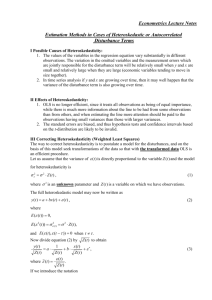Dealing with Departures from OLS Assumptions
advertisement
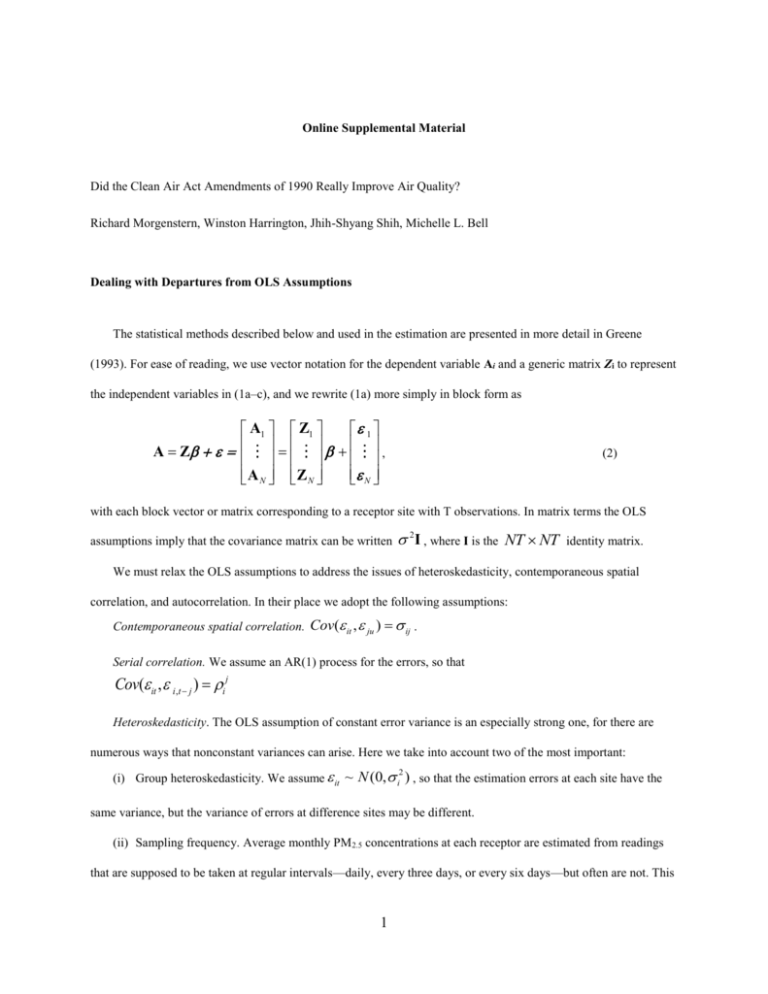
Online Supplemental Material Did the Clean Air Act Amendments of 1990 Really Improve Air Quality? Richard Morgenstern, Winston Harrington, Jhih-Shyang Shih, Michelle L. Bell Dealing with Departures from OLS Assumptions The statistical methods described below and used in the estimation are presented in more detail in Greene (1993). For ease of reading, we use vector notation for the dependent variable Ai and a generic matrix Zi to represent the independent variables in (1a–c), and we rewrite (1a) more simply in block form as A1 Z1 1 A Z , A N Z N N (2) with each block vector or matrix corresponding to a receptor site with T observations. In matrix terms the OLS assumptions imply that the covariance matrix can be written 2I , where I is the NT NT identity matrix. We must relax the OLS assumptions to address the issues of heteroskedasticity, contemporaneous spatial correlation, and autocorrelation. In their place we adopt the following assumptions: Contemporaneous spatial correlation. Cov( it , ju ) ij . Serial correlation. We assume an AR(1) process for the errors, so that Cov( it , i ,t j ) i j Heteroskedasticity. The OLS assumption of constant error variance is an especially strong one, for there are numerous ways that nonconstant variances can arise. Here we take into account two of the most important: (i) Group heteroskedasticity. We assume it ~ N (0, i ) , so that the estimation errors at each site have the 2 same variance, but the variance of errors at difference sites may be different. (ii) Sampling frequency. Average monthly PM2.5 concentrations at each receptor are estimated from readings that are supposed to be taken at regular intervals—daily, every three days, or every six days—but often are not. This 1 means that the number of daily readings in a month can vary from 1 to 31, and for that reason the precision of monthly estimates will differ greatly for different months even at the same site. We deal with sampling frequency first, and then everything else in a single step. Sampling frequency. As discussed above, in Section 2, most of the receptors in the sampling network had periods when very few daily measurements were being made. To obtain a balanced panel, we were forced to use such receptors; if we had not, we would have had very few receptors with which to do the analysis. Rather than discard a receptor, it was better to discount the importance of the months that had only a few daily observations. The correction is based on the well-known formula for the variance of a sample mean. If Aiym diymj Niym in (1a–c) is the mean of N iym daily observations, which we assume to be independent and identically distributed, then var( Aiym ) var(dij ) / N iym is the sampling variance of the Aiym . We can correct for the nonconstant sampling variance by weighting the observations by either the monthly variance directly or the number of observations for the month. It turns out that weighting by the number of monthly observations is far superior because it guarantees that months at individual monitors with few observations get small weights. Using the monthly variance gives too much weight to months with very few observations that happen to be very close in magnitude. Therefore, in the first step of the estimating procedure we transform (2) to N .* A N .* Z N .* , where (2a) N is a column vector containing the square root of the number of daily observations in each monthly estimate, and .* the operation of pairwise multiplication. Correcting for contemporaneous spatial correlation, serial correlation, and group heteroskedasticity. If Z represents the complete matrix of independent variables in (1a) and then the errors ˆ the vector of coefficients estimated by OLS, eit Ait Zˆ it for t=1,…,T. The error structure of (2) is now 11 V N 1 1N , NN where 2 (3) 1 j 2j 1 j ij i2 ij i 1 1 i j i T 1 i i Tj 1 Tj 2 1 (4) OLS cannot be used to estimate the models (1a–1c) with the error structure in (3) and (4). Instead, we use feasible generalized least squares (FGLS) and maximum likelihood (ML) (Greene 1993). These methods are asymptotically equivalent but can give very different results in small samples. With our relatively large data set, we find the results are quite similar for the two estimation methods. The generalized least squares estimator for the model is ZT V 1Z ZT V 1A . 1 To estimate (5) we need estimates for the parameters in each ij in (4). The basic strategy is to estimate (1a) using OLS and use the OLS residuals to estimate the site-level error variances coefficients (5) i2 and the autocorrelation i . Denoting the OLS residuals by eit , our estimates of these parameters are sii si2 1 eit ei (t 1) eit2 and ri (T 1) si2 , T t (6) respectively. Contemporaneous Spatial Correlation Unfortunately, we cannot use a similar method to obtain estimates of the covariance terms in (4) because too many covariances are required. Although we can compute the sample covariance for any two sites by sij eit e jt / T , the matrix sij would not be of full rank. With 193 receptors and 84 months of data, we would have 18,528 covariance terms to estimate and only 16,212 observations. We use the fact that the observed correlations are strongly related to distance to estimate a simple model of covariance. That is, we specify that the error covariance between sites i and j depends on the error variances at each site and an exponential function of the distance D (i, j ) between them, and we estimate this covariance ij by sij si s j exp 2 D i, j . 3 (7) Then we estimate the decay coefficient by finding the best least squares fit to the site-level empirical correlations. The expressions in (6) and (7) give us everything we need to produce a FGLS estimator of the . The same expressions also provide the starting values for estimates of the σs and the s in the maximum likelihood estimation (MLE). 4 Using Estimated Coefficients to Generate Counterfactuals To generate a set of n random draws from a common normal distribution N ( , ) , we draw a set of n 2 standard normal variables ui , where ui ~N(0,1), and the desired set of random draws is xi ui . For a multivariate normal random variable coefficient vector The parameter vector has the distribution N as in (5) above, the procedure is analogous. ,Var , where Var ( ) is the covariance matrix of . Because Var( ) is positive definite, it can be written as CCT , where C is a matrix whose columns are the characteristic vectors of Var( ) and is a matrix that has the (all positive) characteristic roots along the diagonal and zeros elsewhere. Now if we draw a standard normal vector u dimensionality as , then the vector x uT (u1, u2, ,..., uk ) , with the same C u has the required distribution N ,Var 5

